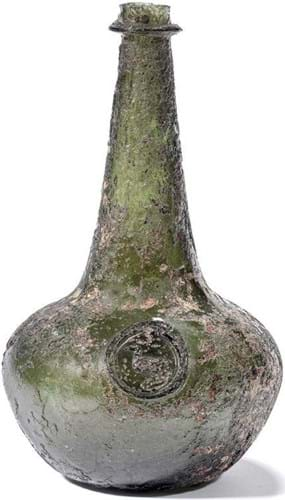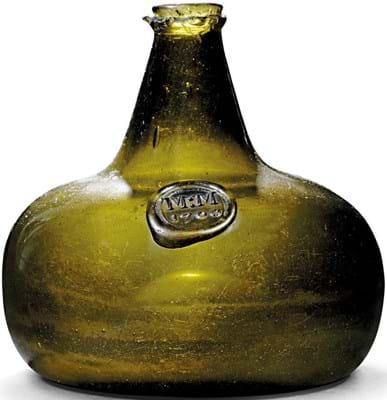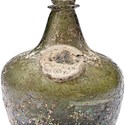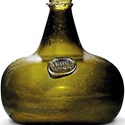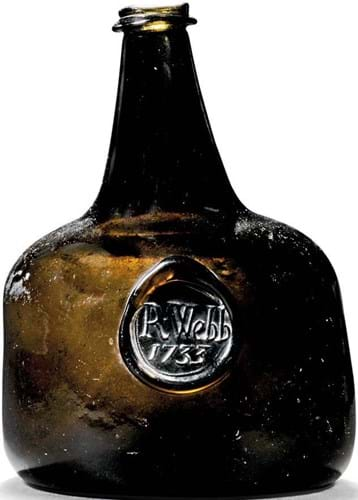
An octagonal bottle with the seal JM Reeve 1738, £6500 at the sale of collection of David Burton at Bonhams.
Pouring wine at the table from a standardised machine-made bottle is a relatively new custom.
In fact, as bottles were rarely of a standard size until the Victorian era, it remained illegal to sell wine by the bottle in England until 1860 and instead wine was typically bought and stored in the cask and only decanted for use at the table.
Stoneware or leather vessels were gradually replaced by ‘black’ glass in the 17th century.
As wine bottles were privately rather than vineyard owned, it was not unusual for them to carry seals denoting the country house or public house for which they were made.
Sealed bottles with coats of arms, names, dates and places have long commanded a significant premium in the collecting arena: many enthusiasts enjoy the social history and genealogical research that the subject offers.
Among the most dedicated of scholars in this field is Kent collector David Burton. Buying and researching since the 1970s, he was able to unlock the history behind more than 5000 different recorded British sealed bottles in the three-volume Antique Sealed Bottles 1640-1900 and the Families that Owned Them (2014).
Collecting aspiration
Bottles from Burton’s collection, each of them pictured and discussed in his magnum opus, were offered for sale by Bonhams (27.5/25/20/14.5% buyer’s premium) as part of the Knightsbridge sale of Fine Glass and British Ceramics on June 21.
All collectors aspire to own a ‘shaft and globe’ wine bottle, the ‘first’ English glass wine bottle that became popular from the 1640s.
The current auction record for a sealed bottle stands at £18,000 bid at Yorkshire’s BBR Auctions in 2018 for a shaft and globe with the seal GR and the date 1682. It had been bought as a copy a decade earlier for just £30.
Burton’s example stood 9in (23cm) high, dated from c.1660-65 and was applied to the shoulder with a circular seal moulded with a goose or swan on a gridiron. Recovered from the Thames at Wapping, this is one of only three bottles known with this seal – the others in the Museum of London were recovered from a dig at Kingsway, High Holborn – and they were probably made for the same tavern keeper. A candidate is the Lyre and Swan pub at the west end of St Paul’s Churchyard, which subsequently became the Goose and Gridiron in the early 1700s.
In ‘excavated’ condition, it took £3000 (estimate £2000-4000).
Forms evolve
Bottle form evolved over time. Typically, the squat, broad and rounded ‘onion’ form bottles are associated with the period c.1690-1720s, so Burton’s vessel in pale green glass dated 1683 is very early. Most sealed bottles of this date are ‘transitional’ forms. It is of added interest as the seal reads R How at Chedworth, a reference to the village just north of Cirencester and Sir Richard Grobham Howe (c.1651-1730), an MP for Wiltshire.
Burton had bought it at Sotheby’s in December 1978. Here it went at the lower end of a £5000- 6000 estimate.
A second onion in olive-green glass with an unidentified seal inscribed MM 1700 sold at £4200 (estimate £2000-3000), while a ‘mallet’ form bottle in dark olive-green glass with the seal inscribed R Webb 1733 took £2800. They are both the only known examples of their type.
Sleeker shapes
It was not until the middle of the 18th century that onion and mallet-shaped bottles fell from fashion to be replaced by the longer, sleeker bottles suitable for ‘laying down’ that are still used today.
Something of a transitional form is a rare octagonal bottle in olive-green glass with a seal inscribed JM Reeve 1738.
A number of these have been discovered in the US and they may be associated with US families.
Although the identity of the owner is unclear, Reeve was a common surname in Virginia and other colonial outposts and an identical octagonal form bottle is known in a US collection. It was estimated at £4000-5000 but made £6500.
Outsized appeal
Typically, bottles from later periods are more affordable and priced in the low hundreds. However, an exception are the outsize bottles made to contain large quantities of liquid.
Sealed double magnum bottles from the 18th century are very rare and the example here in dark olive-green glass has a small seal inscribed B Chilton 1764. Larger still is a jeroboam wine bottle with seal inscribed R Crig Merriott 1803. This is the second-largest sealed bottle recorded, beaten only by another dated jeroboam with a seal inscribed F Arthur 1794.
Very few bottles of this impressive size would have been blown at this date, and it is likely to have been made to commemorate an important event. Merriott is a small village in Somerset between Ilminster and Yeovil and the name on this huge bottle relates to the Cridge family. A Richard Cridge married Mary Shulter on February 15, 1803, and it seems plausible that this bottle was commissioned to celebrate the event.
These two giants were both contested to £2000 each.


